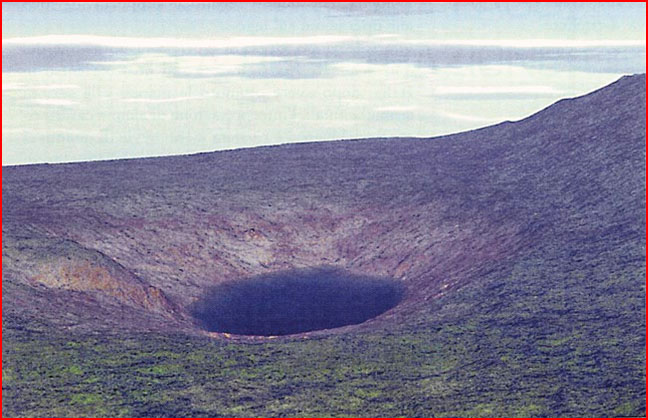I have read about a meteor being the
likely reason ..but seems it may have come from a passing comet!
Solving the Mystery of the Biggest Natural Explosion in Modern History
On the morning of June 30, 1908, the sky exploded over a remote region of central Siberia. A fireball as powerful as hundreds of Hiroshima atomic blasts scorched through the upper atmosphere, burning nearly 800 square miles of land. Scientists today think a small fragment of a comet or asteroid caused the "Tunguska event," so named for the Tunguska river nearby. Now, a controversial new scientific study suggests that a chunk of a comet caused the 5-10 megaton fireball, bouncing off the atmosphere and back into orbit around the sun. The scientists have even identified a candidate Tunguska object—now more than 100 million miles away—that will pass close to Earth again in 2045.

Lake Cheko in the Siberian region of Tunguska has been considered an “impact site” of the Tunguska explosion of 1908.
Note: It is
estimated that the "Tunguska event had an explosive energy roughly on order of 60 A-bombs, or 500 KT of TNT. It was closer in effect to a very large H-bomb."
In kinda related news, this was reported last week..
Maybe an Asteroid Didn't Kill the Dinosaurs
but maybe..
Massive volcanic eruptions in India killed them off!
The commonly told "tale":
Some 65 million years ago — as we've all come to know — an asteroid struck the earth, sending up a cloud that blocked the sun and cooled the planet. That, in turn, wiped out the dinosaurs and made way for the rise of mammals. The suddenness with which so many species vanished after that time always suggested a single cataclysmic event, and the 1978 discovery of a 112-mile, 65-million-year-old crater off the Yucatán Peninsula near the town of Chicxulub seemed to seal the deal.
The asteroid charged with killing the dinosaurs, after all, left more than the Chicxulub crater as its calling card. At the same 65-million-year depth, the geologic record reveals that a thin layer of iridium was deposited pretty much everywhere in the world. Iridium is an element that's rare on Earth but common in asteroids, and a fine global dusting of the stuff is precisely what you'd expect to find if an asteroid struck the ground, vaporized on impact and eventually rained its remains back down. Below that iridium layer, the fossil record shows that a riot of species was thriving; above it, 65% of them went suddenly missing.
Now:
A study in the Journal of the Geological Society throws all that into question. The asteroid impact and dinosaur extinction, say the authors, may not have been simultaneous, instead occurring 300,000 years apart. That's an eyeblink in geologic time, but it's a relevant eyeblink all the same — one that occurred at just the right moment in ancient history to send the extinction theory entirely awry.
Keller and Addate worried that we were misreading both the geologic and fossil records.
Long story short...(see above link for details, if interested)
So if the Chicxulub asteroid didn't kill the dinosaurs, what did? Paleontologists have advanced all manner of other theories over the years, including the appearance of land bridges that allowed different species to migrate to different continents, bringing with them diseases to which native species hadn't developed immunity. Keller and Addate do not see any reason to stray so far from the prevailing model. Some kind of atmospheric haze might indeed have blocked the sun, making the planet too cold for the dinosaurs — it just didn't have to have come from an asteroid. Rather, they say, the source might have been massive volcanoes, like the ones that blew in the Deccan Traps in what is now India at just the right point in history.
And so, dinosours were rendered extinct by India back then too, like a friend quipped! :)
Related: This 1993
report on the "Deccan trap"
A huge outpouring of the earth's interior that occurred over much of present-day India 65 million years ago came from the boundary between the earth's lower mantle and its molten iron core some 1,800 miles beneath the surface. ..... volcanic activity incubated for 3.5 million years before erupting, rapidly blanketing the Indian subcontinent with more than 1 million cubic kilometers of lava. The stack of lava is now known as the Deccan Traps.
clearly says:
"This paper's primary importance is on how flood basalts form and how they evolve," says Renne, who notes nevertheless that "the results will be interpreted in different ways by different people" seeking to explain the demise of the dinosaurs. "No definite link between the Deccan volcanic activity and the disappearance of the dinosaurs has been proven," he notes.
So, presumably this report last week is not new speculation - just old speculations that won't die with time. Sometimes its amazing what "news" gathers feet after it hits the press wires! Soon all major MSM outlets start reporting it and we believe it as novel news or worse still as the gospel truth! I think many naysayers of global warming would also say the same about a lot of "news" related to global warming and its effects; many of these also start and spread like this from press releases put out by various researchers or universities. Very soon it becomes difficult to tell science and facts from speculation and theories!


















